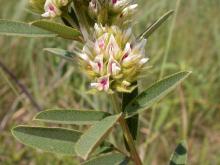Wildflowers, Grasses and Other Nonwoody Plants
Media

Species Types
Scientific Name
Xanthium strumarium
Description
Common cocklebur occurs statewide in open, disturbed, lowland habitats. It is a common weed in crop fields. It has wide, rough, coarsely toothed leaves; stout, often purple-speckled stems; and characteristic burs with hooked spines.
Media

Species Types
Scientific Name
Cuscuta spp.
Description
Dodders are easy to identify, even though at first you might not recognize them as plants. These parasitic plants usually look like a hairlike mass of yellow or orange, leafless, wiry, vining stems wrapping around the stems of other plants.
Media

Species Types
Scientific Name
Lespedeza capitata
Description
Round-headed bush clover is a stiffly upright plant that has rounded flower clusters with cream-colored, pea-shaped flowers with purple markings on the banner petal. It grows statewide in open habitats.
See Also
About Wildflowers, Grasses and Other Nonwoody Plants in Missouri
A very simple way of thinking about the green world is to divide the vascular plants into two groups: woody and nonwoody (or herbaceous). But this is an artificial division; many plant families include some species that are woody and some that are not. The diversity of nonwoody vascular plants is staggering! Think of all the ferns, grasses, sedges, lilies, peas, sunflowers, nightshades, milkweeds, mustards, mints, and mallows — weeds and wildflowers — and many more!





















